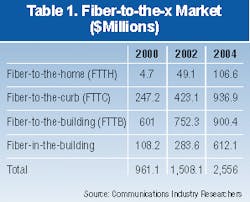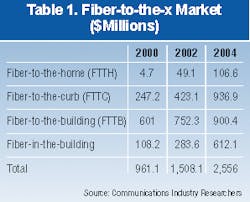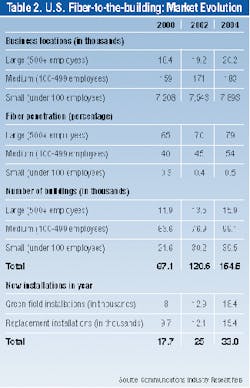Fiber-to-the-building first to take off in close-in markets
C. David Chaffee
Communications Industry Researchers
After a number of false starts, fiber-to-the-x (FTTX) systems have begun to make in-roads in the business market. In the past, such efforts were based on artificial stimulants such as video on demand, and the market push came from the carrier side. Today's installations are driven by customers' demand for bandwidth, in response to the Internet and related broadband services such as video streaming. The result is widespread implementation of fiber optics to major corporate buildings and campuses.
Multinational corporations today view bandwidth as a key difference between success and failure. By relying on a fiber-optic telecommunications infrastructure, these companies discover that bandwidth constraints no longer interfere with business demands. A non-fiber solution often leads to a replacement scenario that eventually costs far more and causes the company aggravation as its capacity begins to tap out.
A key finding in the Communications Industry Researchers' (CIR) report "Fiber-to-the-x: The New Market for Fiber to the Desk, Cabinet and Home" is that most of the new, large corporate buildings in Japan, the United States, and Western Europe are wired with fiber optics. At the same time, hundreds of older buildings are getting retrofitted with fiber. In today's broadband environment, the large companies that occupy these buildings-unless there for a temporary stay-no longer have the option to deploy anything less than fiber.To exemplify this trend, millions of small-form-factor (SFF) connectors have been installed in and around corporate campuses by vendors selling the various SFFs such as MT-RJ, being promoted by Tyco, Corning's Siecor, and other vendors; LC made by Lucent and including other companies such as Sumitomo; and Volition, led by 3M, but also including other companies. A surprising industry trend is the rapidity at which fiber is moving to the building and campus, with the bandwidth bottleneck migrating back out into the network. Some observers expected this push to come in the other direction, with large interexchange-type dense wavelength-division multiplexing (DWDM) units penetrating deep into the local exchange. That really has not happened, at least not anywhere near projected levels.
The predominant trend is fiber-to-the-building (FTTB), a market CIR estimates will reach more than $600 million this year (see Table 1). That is more than the fiber-to-the-home (FTTH), fiber-to-the-curb (FTTC), and fiber-in-the-building markets combined. Those markets will become comparable over time, but the preponderance of close-in fiber will be geared to the business in the next several years.
FTTB is reaching critical mass faster than fiber to residential builds in part because business applications generally drive new technologies. FTTX is no exception. While this technology has existed for many years, past FTTH schemes were largely fanciful, not based on real economics.
An important realization in the new millennium is that bandwidth means money. It allows companies to communicate more effectively and to have access to information. It is hard to name a sector of business that is not improved by the Internet and information sharing. When businesses can cost justify a new technology, the penetration of that technology can happen quickly; the amounts of money that even the smallest business can invest are invariably greater than what individual consumers can spend.
Not only do businesses need a growing amount of bandwidth, service providers have more incentive to target this market. The marketing and other resources required to win and retain a residential account is relatively large compared to a business account. That makes business accounts attractive, not only to incumbent local-exchange carriers (ILECs), but also to competitive local-exchange carriers (CLECs). Traditionally, there has been more competition to provide services to businesses than to residences. This trend is slowly changing, however, especially in the more affluent residential areas.
CIR estimates that 65% of the largest industrial and commercial buildings in the United States will be connected to fiber optics by the end of this year (see Table 2). The major market not included at this time is older buildings, where fiber can't always be justified. However, CIR expects that even in these buildings, fiber will become an essential part of the building infrastructure, if only to attract premium tenants.
While the number of medium-sized businesses directly connected to fiber networks does not represent as high a percentage as large businesses, the growth in this segment is very healthy. There are major efforts to connect medium-sized and small businesses to fiber, if these companies occupy space in large business areas. The ability to provide bandwidth is a key selling point for building owners.
CIR projects that the fiber-in-the-building market will grow substantially between 2002 and 2004. Less than 3% of buildings connected to fiber-based networks have fiber-in-the-building. This is an important market, as in-building customers will start to demand more and more bandwidth.
The in-building optical-fiber market consists of fiber-to-the-wiring closet and fiber-to-the-desk. It is not uncommon today to find fiber-to-the-wiring closet, with horizontal distribution via twisted-pair copper cable, in large buildings. Fiber-to-the-desk, however, is far less common.
Fiber-to-the-desk, economically, does not make sense without fiber-to-the-wiring closet. The fiber-in-the-building market will only occur in force when the percentage of buildings that have fiber-to-the-wiring closet and fiber-to-the-desk increases. CIR expects 20% of employees working in buildings that have fiber to the wiring closet to also have fiber to the workstation by 2004.
The FTTB market is emphasized in this report because it is currently taking off. A market growing much faster in the five-year time frame, which is expected to eclipse fiber-to-the-business by 2004, is FTTC. Although there is the tendency to only think in terms of FTTB or fiber-to-the-residence, a lot of fiber is going in near homes, and this trend will escalate in the next several years.
One reason for this is the growing competition among cable-TV providers, ILECs, and independent carriers such as clearworks.net and RCN. The clear mission is to provide greater amounts of bandwidth to a clientele that is growing in sophistication, especially when it comes to Internet services.
BellSouth adopted a policy in 1996 that all new residential developments it serves will use FTTC distribution systems. By the close of 1998, BellSouth had 34,161 pedestal locations, 40,993 fibers serving pedestals, and 220,857 customers that had access to pedestal locations.
During 1999, BellSouth adopted the policy that it would not just use FTTC for new builds but would actually begin replacing copper distribution with the same FTTC systems. The first "replacement" implementations occurred in the Atlanta metro area and in south Florida (Miami and Fort Lauderdale).This policy shift opens the door for the wholesale replacement of copper, especially as the demand for broadband services increases. To support its aggressive pro-FTTC stance, BellSouth signed a deal with Macroni/Reltec to bring large amounts of fiber into its network through 2002. The Macroni/Reltec "deep-fiber" system will be used to deliver Asynchronous Transfer Mode (ATM)-based broadband entertainment and Internet service throughout the nine-state BellSouth region. BellSouth may spend as much as $1 billion with Macroni/Reltec during the next several years on this architecture.
Other carriers are also bringing fiber closer to homes. Bell Atlantic has formed a partnership with Metromedia Fiber Network to gain fiber access near homes along large sections of the East Coast. Similarly, SBC Communications is pursuing a $6-billion telecommunications architectural build-out known as Project Pronto. It was initially expected to provide widespread asynchronous digital-subscriber-line (ADSL) services, but there are already indications that the carrier plans fiber close to the home in some instances.
What about fiber-to-the-home, which in some respects represents the final frontier of telecommunications carriers' build-outs?
FTTH has not taken off like the FTTB market, and it is not expected to for a number of years. Some new housing developments and existing neighborhoods are connecting homes to fiber. CIR estimates that a little more than 1,100 homes in the United States today are connected to fiber; that number is expected to grow to more than 180,000 by 2004.
Competition is likely to hasten fiber near and to the home. In affluent areas, cable-TV companies are already bringing fiber to nodes, which are getting closer and closer to the home. Similarly, telephone companies are bringing fiber closer in, as are independent carriers such as RCN.
When fiber is close to parity with copper from a cost standpoint, and builders realize there will never be a need to remove it because of capacity constraints, FTTH will begin to be viewed as an economical solution. Broadband services to the home must also emerge to fully justify the installation of fiber, although many believe that such services will soon appear.
The potential market is extraordinary. There are approximately 103 million households in the United States, with that number expected to reach about 108 million by 2004. FTTH installations cost between $1,000 to $2,000 per home.
Not surprisingly, there is a certain lack of belief among some in the industry regarding the rapidity with which fiber has come to service close-in applications. Those misgivings, however, are based on overly zealous past reports regarding FTTH. But it is dangerous to dismiss other close-in fiber installations out of hand because the fiber-to-the-home market is still nascent. Today, business represents the first critical need for broadband services, which requires bandwidth that fiber is best suited to accommodate.
C. David Chaffee is the director of fiber-optic research at Communications Industry Researchers (Charlottesville, VA). He is also founder and CEO of Chaffee Fiber Optics (Columbia, MD).


